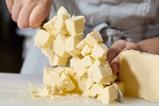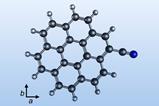Sarah Gerhardt’s curiosity connects her passions for science, teaching and surfing

‘I definitely would show up to organic chemistry unprepared and lean over and have water dripping out of my nose,’ reveals Sarah Gerhardt, the first woman to surf Mavericks – the infamous cold water big wave on the coast of California, US. She is also the deputy chair of the chemistry department at Cabrillo College in California with a dynamic career in teaching and a PhD in physical chemistry.
Growing up by the ocean, Gerhardt had an appreciation for nature and the world. But she fell in love with chemistry when learning about the periodic table and nomenclature in high school. At the same time, she developed an interest in surfing. ‘I was the only girl in my county [my age]. I was an oddity,’ says Gerhardt.
While she pursued her chemistry qualifications she would hit the water. ‘I do have ADHD and surfing stimulated all these different areas of the brain at the same time,’ she explains, saying that this distraction proved beneficial when she was working on a research project or completing homework. ‘The thing that connects science and surfing to me is curiosity,’ she says.
Gerhadt encountered Mavericks during grad school. She met with some challenges – at first, she wasn’t physically ready for the heavier, gnarly waves. But everything clicked on her third attempt. ‘I was on my own board made just for me. And just everything, all the pieces came together. I started riding waves and it was amazing. And then I went again.’ A photographer captured the achievement and Gerhardt was featured on the online Surfer Magazine in 1999 as the first women to ever surf Mavericks.
Back in the lab
As this feat brought her fame, she was still pursuing her passion for chemistry. After interning in Australia on a project during her undergraduate studies looking at surface force microscopy, Gerhardt knew that she wanted to pursue either surface science or analytical chemistry. ‘But I also was interested in teaching,’ she explains. After starting her PhD with a lab focusing on quantum dots, she realised she didn’t love her particular project, so she did some searching and found an area that excited her. ‘If you’re going to try to treat cancer, you can use a porphyrin … and that’s what I ended up doing the rest of my research on, what functional groups can you put on the porphyrin that will allow penetration deeper into the cell?’
While she was working on her PhD at the University of California at Santa Cruz she was also teaching, ‘I was honoured to win a teaching assistant award [during my PhD] for the chemistry department … and I was like this is definitely what I want to do.’
My goal is to engage students through storytelling
Gerhardt switched to teaching at night at Cabrillo community college part time after giving birth to her first son. It was challenging; ‘it was really hard to take care of a kid and prep for classes and then I had my daughter not even two years later.’ Gerhardt knew she wanted to get back into full-time work. ‘I wanted to expand my opportunities and horizons,’ she says, and so pursued a postdoc position while she decided whether she wanted to teach and do research, or just teach.
She taught herself cell biology and a little microbiology to come up with a research proposal to engineer a new protein that can be tagged with a fluorophore to provide insight to the behaviour of the ribosome. ‘I handed Harry Noller [principal investigator] my research proposal … and the next month, he went and hired somebody to start the project. They were the first people to do single molecule spectroscopy of the ribosome.’ The postdoc provided an incredible opportunity to learn and led Gerhardt to conclude the direction she wanted to go – ‘ultimately teaching 100%’.
She now has been teaching chemistry (her favourites being general organic and biological chemistry) full-time since 2011 and loves her job, bringing current research into the classroom to inspire her students ‘such as [the] Frito Lay Salt Hopper cube morphology patent!’ She brings in surfing when teaching quantum mechanics (waves) and when the students discuss physical and chemical reactions such as acidification of the ocean. ‘I am doing a year-long (study) programme on equity and justice in learning,’ adds Gerhardt on her current ambitions of increasing access to chemistry for her students. She hopes to gain a better understanding of the challenges facing people in underprivileged groups and bring about new teaching methods to close success gaps.
She hasn’t let up on the surfing however. ‘I continue to surf if I can every day because it helps me be grounded and stay focused,’ says Gerhardt. She has no desire to slow down her teaching either. ‘My goal is to engage students through storytelling and a desire for learning to make this planet a better place for all of us to live.’

















No comments yet